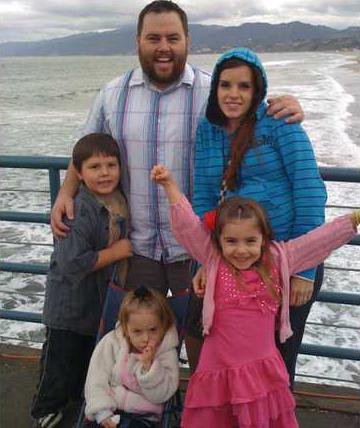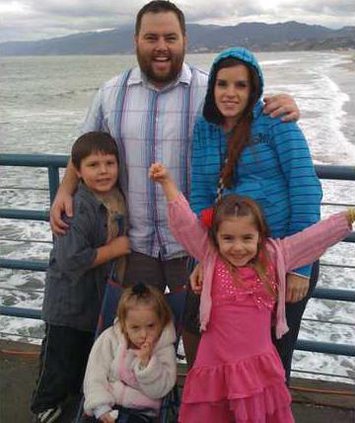When Shay Butler and his then-11-year-old son Gavin Butler started a 30-day challenge to eat healthier and lose weight last summer, it was a challenge they planned to do together.
He was excited, Shay Butler said of Gavins reaction. They listed some activities they wanted to do, including swimming, biking, soccer, running and basketball.
When Butler, a digital entrepreneur and vlogger known for his Shaytards YouTube channel, would travel for work, Gavin came along too.
No matter where I was, he traveled with me, Butler said in an interview with the Deseret News. Its been a big relationship-building experience for us.
Their journey along the 30 days is included in their book, Fat Dad, Fat Kid: One Father and Sons Journey to Take Power Away From the F-Word (Atria/Keywords Press, $16.99), which was released Dec. 29. The lime green on the cover, turning the word Fat to Fit, was Gavins idea, Butler said.
One of the biggest challenges they had during the 30 days was not eating sugar.
When youre done with dinner and you want dessert, you want dessert, Butler said. When you cant have dessert, its really, really hard.
But he didnt cheat once.
The only reason I didnt cheat was because of my son, Butler said. Hes strong, hes strong-willed.
And knowing Gavin was keeping his end of their challenge helped Butler stay away from treats and other foods with processed sugar, such as soft drinks.
Gavins perspective is shared through journal excerpts along with several father-son conversations from during the 30 days.
There have definitely been times when Ive really wanted something thats not healthy, and weve been able to talk each other through it, Gavin wrote on Day 16. The other night, I was eating homemade pizza and we talked about how its not healthy to eat another slice just because we want it.
The 208-page book has 30 chapters, one for each day of the challenge, and each chapter is centered around a lesson from the challenge or a life experience that helps contribute to living a healthier lifestyle.
Butler shares about how he got into posting YouTube videos and how it became his familys main source of income, stories from his active childhood, and how he slowly but surely gained weight.
You get more focused on a career and providing for your family than having a healthy body, Butler said. He also shares about his initial weight-loss journey, when he weighed 281 pounds and decided he needed to be healthier.
He signed up to run a marathon, printed the registration and hung it on the refrigerator.
I couldnt even run one mile, he said. I went out for that first run, and I couldnt make it around the block.
The first step was setting a reasonable time frame in which to do it.
I knew that if I worked for six months, I could do it, he said.
He bought a bike and started riding it on a trail along Venice Beach.
I kept going farther and farther every day, he said. I worked up until I could ride my bike 20 miles in one outing, and that was a huge accomplishment for me.
Then he ran the marathon, along with a handful of others. He documented his journey on the ShayLoss YouTube channel.
Butler took the lessons he learned about health and losing weight while training for the marathon and applied them during the 30-day challenge with his son.
The secrets of life are hiding in the word cliche, Butler said. He pointed to eating fruits and vegetables, drinking enough water, getting enough sleep, exercising and working hard.
After the marathons, he was burned out with running, and eventually 30 pounds crept back on, he said.
When the book opportunity came along, he decided he wanted to do the 30-day challenge with his son and write about it.
I just want to motivate people to realize that we have a limited amount of time on this earth and we are alive on it right now, he said. And these memories were creating with our loved ones are the most valuable commodities you can have. In order have more of them and better of them, we need to have healthy bodies.
Butler recognizes hes not an expert.
Ive never claimed to be an expert, he writes in the book. Im just a regular dude trying to lose weight and get in shape, and trying to bring his son along on the journey to find healthier ways to live his life. Regular dudes fail. They mess up and have to start all over again.
Now, his New Years resolution is to not drink soft drinks.
Since Jan. 1, Butler and Gavin have been posting videos representing each chapter of their book along with exercises to do at home on the ShayLoss YouTube channel.
He was excited, Shay Butler said of Gavins reaction. They listed some activities they wanted to do, including swimming, biking, soccer, running and basketball.
When Butler, a digital entrepreneur and vlogger known for his Shaytards YouTube channel, would travel for work, Gavin came along too.
No matter where I was, he traveled with me, Butler said in an interview with the Deseret News. Its been a big relationship-building experience for us.
Their journey along the 30 days is included in their book, Fat Dad, Fat Kid: One Father and Sons Journey to Take Power Away From the F-Word (Atria/Keywords Press, $16.99), which was released Dec. 29. The lime green on the cover, turning the word Fat to Fit, was Gavins idea, Butler said.
One of the biggest challenges they had during the 30 days was not eating sugar.
When youre done with dinner and you want dessert, you want dessert, Butler said. When you cant have dessert, its really, really hard.
But he didnt cheat once.
The only reason I didnt cheat was because of my son, Butler said. Hes strong, hes strong-willed.
And knowing Gavin was keeping his end of their challenge helped Butler stay away from treats and other foods with processed sugar, such as soft drinks.
Gavins perspective is shared through journal excerpts along with several father-son conversations from during the 30 days.
There have definitely been times when Ive really wanted something thats not healthy, and weve been able to talk each other through it, Gavin wrote on Day 16. The other night, I was eating homemade pizza and we talked about how its not healthy to eat another slice just because we want it.
The 208-page book has 30 chapters, one for each day of the challenge, and each chapter is centered around a lesson from the challenge or a life experience that helps contribute to living a healthier lifestyle.
Butler shares about how he got into posting YouTube videos and how it became his familys main source of income, stories from his active childhood, and how he slowly but surely gained weight.
You get more focused on a career and providing for your family than having a healthy body, Butler said. He also shares about his initial weight-loss journey, when he weighed 281 pounds and decided he needed to be healthier.
He signed up to run a marathon, printed the registration and hung it on the refrigerator.
I couldnt even run one mile, he said. I went out for that first run, and I couldnt make it around the block.
The first step was setting a reasonable time frame in which to do it.
I knew that if I worked for six months, I could do it, he said.
He bought a bike and started riding it on a trail along Venice Beach.
I kept going farther and farther every day, he said. I worked up until I could ride my bike 20 miles in one outing, and that was a huge accomplishment for me.
Then he ran the marathon, along with a handful of others. He documented his journey on the ShayLoss YouTube channel.
Butler took the lessons he learned about health and losing weight while training for the marathon and applied them during the 30-day challenge with his son.
The secrets of life are hiding in the word cliche, Butler said. He pointed to eating fruits and vegetables, drinking enough water, getting enough sleep, exercising and working hard.
After the marathons, he was burned out with running, and eventually 30 pounds crept back on, he said.
When the book opportunity came along, he decided he wanted to do the 30-day challenge with his son and write about it.
I just want to motivate people to realize that we have a limited amount of time on this earth and we are alive on it right now, he said. And these memories were creating with our loved ones are the most valuable commodities you can have. In order have more of them and better of them, we need to have healthy bodies.
Butler recognizes hes not an expert.
Ive never claimed to be an expert, he writes in the book. Im just a regular dude trying to lose weight and get in shape, and trying to bring his son along on the journey to find healthier ways to live his life. Regular dudes fail. They mess up and have to start all over again.
Now, his New Years resolution is to not drink soft drinks.
Since Jan. 1, Butler and Gavin have been posting videos representing each chapter of their book along with exercises to do at home on the ShayLoss YouTube channel.








